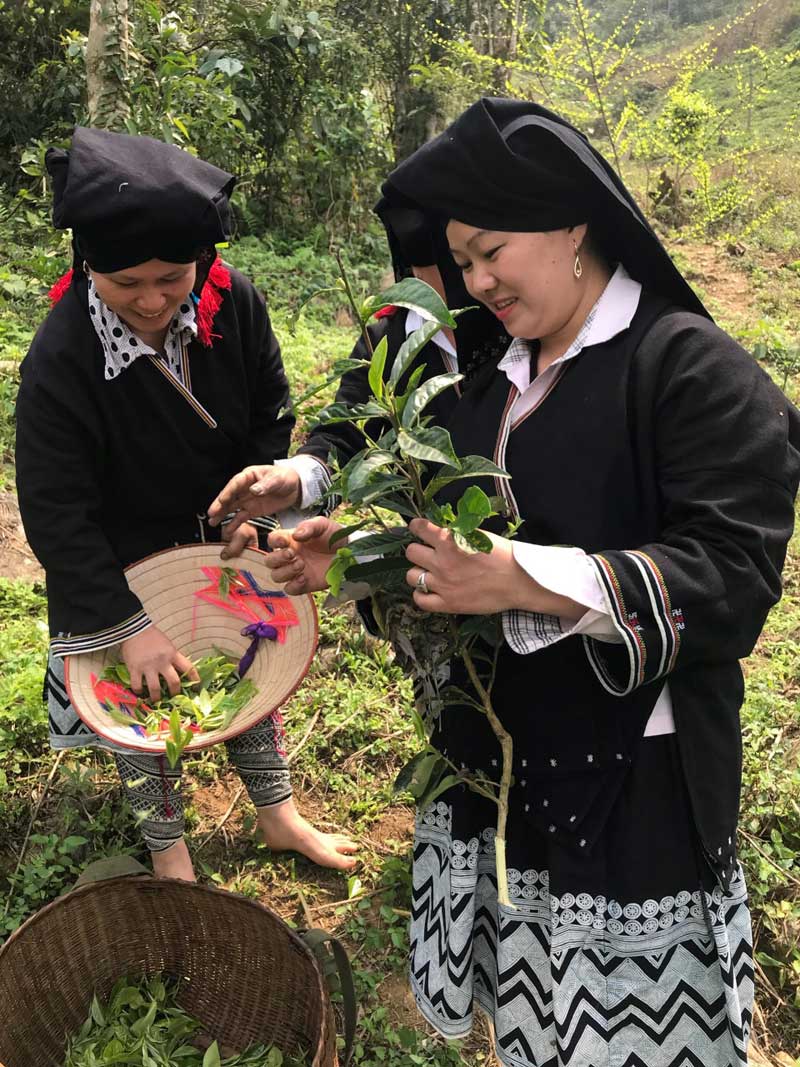
HBO - This season, when travelling to Sung village, Cao Son commune, Da Bac district you can enjoy not only the flavor of Camellia Sinensis (Shan Tuyet tea), but you also can see warm smiles in the small village under the forest canopy. The ancient Camellia Sinensis is becoming a specialty - a gift that anyone coming to Sung village also wants to bring home.
Women in Sung village, Cao Son commune, Da Bac district pick Shan Tuyet tea.
In the 60s and 70s of the last century, when not damming the river to build Hoa Binh Hydropower Plant, Sung village used to be the highest point of Da Bac district with people living there. Mr. Khuong Manh Thu, the secretary of the commune’s Party Committee says that Sung village still preserves the intact traditional cultural identity of Dao ethnic people for hundreds of years.
This cultural identity is not only preserved, but it is also being promoted in a positive and effective way in building a new cultural life. To promote this advantage, the commune has also developed and issued the Resolution No. 02/NQ-DU on "The development of the community tourism in Sung village". Up till now, it has been considered as a breakthrough step, contributing to improving people's lives there.
Currently, there are 75 houses with 364 people in the whole village. In particular, some households do "homestay" travel services such as the families of Ly Van Thu, Dang Van Xuan, Dang Van Nhat and so on. However, you can come and stay at anyone's house. You are also welcomed with sincerity and openness anywhere. As we are in the forest so it is very happy to welcome the guest.
Returning to Sung village, tourists can enjoy ancient Camellia Sinensis, the traditional dishes such as sour meat, hilly chicken, Hoang wine, upland rice and so on. These products are made by the people themselves, so they always keep the purity and the sweet. Tourists can also visit and admire the beauty of a picture of a wild mountain forest with the green rice in the terraced fields. After the harvest, these fields are brightly yellow with beautiful flowers of Brassica napus.
Here, the tradition of maintaining forests around the villages and communes has been maintained from the time of the ancestors. As a result of this, there have been hundreds of year-old precious timber trees such as Parashorea chinensis with the diameter of more than 2 meters in the head of the commune or Syzygium aromaticum and Cassia alata trees, which is as big as 1 - 2 hugs of adults ... The whole forest around the village has never been abused for hundreds of years.
Thanks to the forests, Sung village has become an attractive destination and community tourism on the tourist map of the province. That is evidenced by hundreds of turns of domestic and foreign visitors every month. In particular, they are mainly foreign guests.
A diverse chain of eco-tourism and resort destinations concentrated in Hoa Binh city and the districts of Tan Lac, Da Bac, and Luong Son… Along with the launch of several key high-quality resort tourism projects, these developments have reshaped the landscape and enhanced the appeal of Hoa Binh as a travel destination.
Boasting diverse terrain, a mild climate, and rich natural resources, Cao Phong district is increasingly asserting its place on Vietnam’s tourism map, attracting both domestic and foreign visitors. The district is renowned for its stunning landscapes, majestic mountains, a crystal-clear hydropower lake, and the unique cultural identity of local ethnic groups.
With its pristine landscapes, unique cultural heritage of Muong ethnic minority, and an expanding range of visitor experiences, Tan Lac district of Hoa Binh has fast become a captivating destination for both domestic and international tourists.
Until now, Sung village in Cao Son commune, Da Bac district remains the only Dao ethnic community in Hoa Binh province to develop a community-based tourism model. Beyond its untouched natural landscapes, cultural identity serves as the cornerstone attraction for visitors.
Alongside the diverse cultural identities of the Kinh, Muong, Tay, Thai, Dao, and Mong ethnic people, Hoa Binh province is also renowned as the "capital" of the northwestern Vietnamese cuisine, offering unique and distinctive dishes. At festivals, during Lunar New Year (Tet), or on significant family or community occasions, special dishes are prepared, leaving a lasting impression on visitors.
A Phong Linh (Yellow Tabebuia) flower garden in Thang village, Thach Yen commune, Cao Phong district is currently in full bloom, drawing a large number of visitors.



